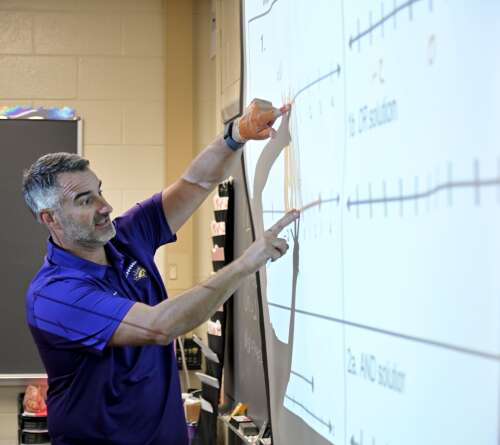As students filed into Jeremy Harkin’s Algebra 2 class at Schaumburg High School on a recent Thursday, he put the question of the day on the board: “What are common mistakes students make when solving compound inequalities?”
Students quickly pulled out their computers and typed in the question to see what ChatGPT had to say.
Discussion ensued, and Harkin’s lesson of the day began.
That is one example of how suburban teachers are integrating generative artificial intelligence programs, like ChatGPT, into their classrooms.
Districts across the suburbs, including Palatine-based Township High School District 211, started allowing high school-aged students to use AI programs in class this year.
“They’re going to find the bad things about it,” Harkin said of AI programs like ChatGPT, acknowledging they can be used to cheat. “But if we teach them how to use it correctly, there’s a lot of benefit to it.”
ChatGPT first came on the scene in 2022, sparking concerns that generative AI programs would increase cheating among students. Several districts blocked student use of such programs and used the time to research and develop policies around their use in the classroom.
In District 211, for example, Harkin participated in professional development sessions offered to teachers on AI. Though this is the first year his students are allowed to use AI programs in class, Harkin used it last year to help develop lesson plans, leveled work sheets and assessments.
Students in Jeremy Harkin’s algebra class at Schaumburg High School use AI at the start of each class to help launch the day’s lesson.
John Starks/jstarks@dailyherald.com
Since its introduction, generative AI has kept the attention of educators — whether it’s concerns about cheating, discussions about how AI can serve as an assistant of sorts to teachers in planning and grading or finding ways to use AI to improve student learning.
“Artificial intelligence really seems to be at the forefront of everything educators are talking about these days,” Illinois State Superintendent Tony Sanders said in one of his “fireside chats” with Khan Academy founder Sal Khan.
Aurora-based Indian Prairie District 204 also opened the door for AI in high school classrooms this year after carefully crafting a policy and guiding principals for AI in the district.
The statement, which can be found on District 204’s website, notes the district “recognizes the transformative power of AI” in education and that the district is committed to using it ethically to enhance, not replace, the connection between teachers and students.
As teachers integrate generative AI into lesson plans, it’s prompting them to re-evaluate assignments to ensure they enhance students’ learning experiences and not just something that can be typed in as a prompt to spit back an answer.
“It’s forcing us to dig deeper and think about how we’re creating authentic experiences,” said Nader Najjar, District 204’s assistant superintendent of equity and innovation. “If (the assignment) is something that can be plugged in and printed out, what’s the purpose?”
Schaumburg High School teacher Jeremy Harkin says he sees benefits to teaching students how to use AI responsibly.
John Starks/jstarks@dailyherald.com
For example, rather than having a student use AI to write an entire paper, teachers can have students use AI to provide feedback on a draft or help generate an outline or ideas for a paper.
If a student is struggling with solving compound inequalities in Algebra, a teacher can suggest that the student ask ChatGPT to provide practice problems or review notes to help master the skill.
Teachers can also use AI to tweak assignments to better meet an individual student’s needs.
“We see a lot of opportunities for personalizing the learning for students,” said Joshua Schumacher, assistant superintendent for curriculum and instruction in District 211.
While AI programs can teach a lot of things, educators agree it won’t replace student work or the teacher-student connection in the classroom that is key for personalized learning and assessment.
There are also still some bugs to work out, educators note. Privacy concerns and age restrictions, for example, have kept AI out of elementary and middle school classrooms, though teachers can still use it to help prepare lessons.
However, educators say AI is likely here to stay and that today’s students will find themselves working in future jobs that make use of AI. Learning how to use it will benefit them for years to come.
“We’re preparing students for a future that we can’t yet determine but likely will have AI embedded in it,” Schumacher said.
Schaumburg High School teacher Jeremy Harkin says generative artificial intelligence programs, like ChatGPT, can be a useful tool to help students who are struggling in certain areas master those skills, get discussions started and help teachers plan their lessons.
John Starks/jstarks@dailyherald.com
